by Winding Pathways | Aug 10, 2023 | Mammals, Nature, Trees/Shrubs
Squirrels: Free Tree Planters
Our neighborhood squirrels proved they are the best tree planters.
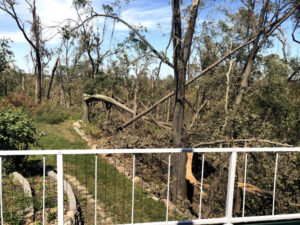
We lost most of our mature trees in the 2020 Derecho.
An August 2020 derecho tore through Iowa pushing 140-mile-an-hour wind against trees and buildings. Trees by the hundreds of thousands tumbled to the ground. Winding Pathways wasn’t spared. We lost most of our firs, oaks, hickories, and cottonwoods. The devastation in nearby Faulkes Heritage Woods was even worse.
Almost immediately, shocked people took action. Government forestry departments, aided by tree planting nonprofits, and private citizens unleashed their shovels and planted thousands of trees. So did the squirrels. Well, not really. People planted trees.
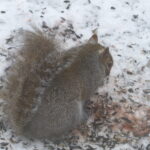
Squirrels bury nuts in caches to retrieve them later.
Squirrels planted nuts and acorns.
Then three seasons of drought followed. Once planted, most trees were not tended as they need to be. So, many human-planted trees shriveled in the heat and dryness, while the nuts buried by squirrels sprouted and the new trees were flourishing.
But why?
We have theories. A human-planted tree seedling needs plenty of moisture to keep its trunk and new leaves hydrated. Sparse roots must pull water from the ground and send it upward. That’s a tough job in a wet year. Come drought it’s nearly impossible.
Squirrels did better. These industrious rodents don’t mean to create new trees. They’re simply storing nuts underground so they have enough fat and protein-rich food to tide them through winter. All they need to do is dig up a nut when hunger calls. Squirrels overfill their larder, burying more tasty nuts than they’ll ever need. Unfortunate squirrels are eaten by hawks, foxes, owls, or humans, but the nuts they’d buried remain patiently waiting for spring’s warmth to germinate.
Sprouting nuts grow roots able to pull scarce moisture from the soil and send it to new baby leaves poking through the ground.
As we walked through July 2023’s dry woods we sadly see human-planted trees shriveled up and dead, while nearby a new generation of tiny walnut, oak, and hickories is rising from nuts planted by industrious squirrels.
-
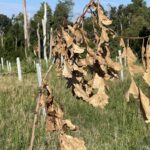
-
Newly planted trees need watering.
-
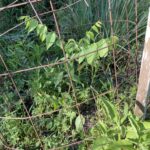
-
This squirrel planted walnut seedling sprouted just this year in spite of the drought.
Squirrels Don’t Plant All The Trees
Squirrels are the best friends of nut-bearing trees, but other tree species can’t rely on the furry rodents. Cottonwoods, for example, produce millions of seeds too tiny for squirrel food. So, the trees grow cottony fluff that floats seeds to distant places. If one lands in a patch of moist bear soil a fast-growing cottonwood sprouts. Maples have helicopter-like seeds that whirl a gig away from the parent to sprout a ways away.
Pity the poor Osage Orange tree that grows huge citrus-smelling balls containing hidden seeds. Many folks call them hedge apples. A tree must get its seeds away from its own shade. Squirrels do the job for oaks. The wind for cottonwoods. Massive mastodons once munched on Osage Orange hedge apples, wandered off, digested the pulp, and pooped out the seeds. When these massive elephants went extinct the tree lost its partner and saw its native range shrink from much of North America to a tiny spot down south.
Nature provides many ways for trees to reproduce and the results are often superior to what humans can do. We appreciate the squirrels that plant nuts many of which sprout into healthy native trees. Thanks, squirrels!
by Winding Pathways | Feb 24, 2022 | Mammals
The birds we share Winding Pathways with have a good life. Our property has old trees, prairies, and bushes to provide lots of natural food plus nooks and crannies for chickadees, nuthatches, and other species to hide and shelter from tough weather.
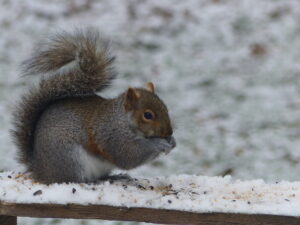
Squirrel tails have many uses.
Birds aren’t the only animals that gorge on the sunflower seeds and corn we daily put in the backyard. Deer, raccoons, and opossums sometimes visit at night. And squirrels constantly work the day shift.
Two Species
Two squirrel species visit our feeders. Grays are more of an eastern species that prefer woodlands with big trees, while Fox Squirrels prefer edges – places where woods meet prairies, cornfields, or meadows. They are most common in the Midwest.
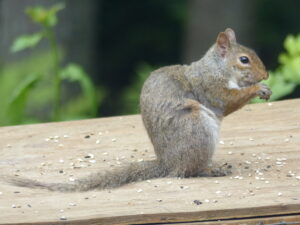
Even in winter the squirrels’ fur looks healthy…except for their tails.
In spring 2021 through winter 2022, we have noticed that many squirrels, especially grays, had few tail hairs, making them look like rat tails. That’s not good for a squirrel.
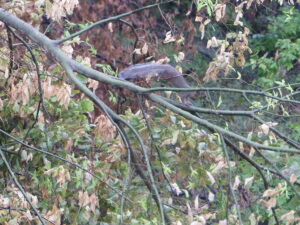
Squirrels use tails for balance.
Their bushy tail is more than an ornament. We’ve observed three important uses. It helps them balance. Notice this when you see squirrels cross wires or balance on tiny branches bouncing in the wind. On cold and wet days, we see squirrels drape their tail over their back, perhaps like putting another blanket on the bed or a poncho. Twice we’ve seen squirrels fall from tall oaks. Both times they “spread eagle” in the air with their legs and tails outstretched. They descended with their body horizontal, hit the ground with a thump, and took off running, apparently unhurt. So, their tail helped them parachute down.
Furless Tails
According to Dr. Neil Bernstein, a squirrel lacking a tail may have been in a mating fight with another male and came out the loser. Four of our resident squirrels have a tail but each lacks hair. It could be mange, but this often leaves a bare patch of skin on the animal’s body. Our squirrels have perfect body hair.
Loss of tail hair could be caused by a fungal disease called dermatophytosis. Often this causes hairs to break off, rather than shed from the skin. A squirrel with this condition has short bristles. We think that’s the case with our squirrels.
Often otherwise healthy squirrels recover from mange or dermatophytosis. We hope ours will.
by Winding Pathways | Feb 10, 2022 | Birds, Mammals, Nature, Pests
Guest Blogger, Dr. No More Squirrels
(Photos by Dr. NMS)
Much of my time and energy has been spent battling a 1-pound enemy – the gray squirrel. I love feeding and watching birds, but with a neighborhood full of acorn-bearing oak trees I feel no guilt at all at not wanting to pay for bird food and letting the squirrels eat it. Through trial and error, I have found how to place all our feeders so that they are always out of the reach of squirrels. Almost always. Every few months a new guy shows up; a determined daredevil squirrel who figures out how to slide 20 feet down the string holding a feeder to get to the mother lode.
-
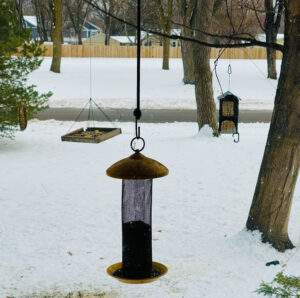
-
A variety of feeders for the birds.
-
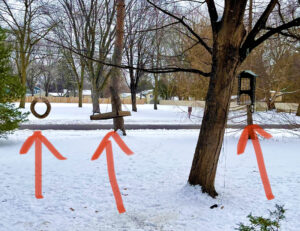
-
the “raiders” jump through hoops to get to the feeders.
When that happens, it’s time for an involuntary relocation.
This was the case on a frigid January morning here in Minneapolis. My live trap was set and within minutes I heard it snap shut. But what I then saw was a shock. The squirrel was trapped all right, but sitting next to the trap was an immature red-tailed hawk! She hopped onto the trap and all around it, trying to get at what she thought would be an easy breakfast.
Minutes later, she gave up and flew to a nearby perch to contemplate how she had been beaten by a 1-pound ball of gray fur.
I knew exactly how she felt.
-
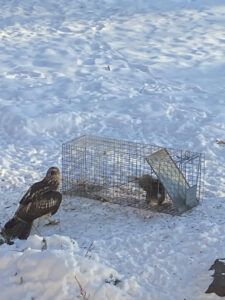
-
This immature red-tail hawk tries to figure out how to get the squirrel.
-
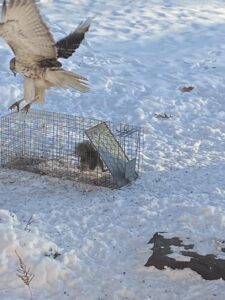
-
Landing on the trap
by Winding Pathways | Feb 13, 2020 | Birds, Mammals, Nature
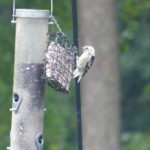
This Albino Woodpecker comes to the feeder regularly.
Several months ago, we looked out our dining room window and saw an unusual woodpecker enjoying suet at a feeder only a few feet away. It was a downy but it’s head was almost completely white, unlike all others of the same species we’ve seen.
Last year we had a fox squirrel with an unusually short tail that hung around our yard for months. We’ve also spotted other wild animals with distinctive markings unusual for their species, healed but visible wounds and other characteristics that help identify it as an individual.
The Power of Observation
Being able to identify an individual animal adds to the fun of wildlife observation. For example, from the squirrel, we learned that he or she mostly just stayed in our yard and nearby woods. We never spotted it at a neighbor’s yard. Then, one day we remarked, “We haven’t seen’ shorty tail’ for a while”. We actually never saw the animal again and assumed he or she met his end due to an accident, predator, car collision, or some other catastrophic incident. Because we could tell him from other squirrels, we know he lived at least ten months.
The piebald woodpecker still comes to our feeder, and we’re getting to know it as an individual rather than just a generic downy. It adds to the fun of wildlife observation.
Like people, animals are individuals. At first glance, every one may look the same but with careful observation, it’s possible to spot differences in plumage, fur, size, shape, gait, and even personality that help identify it as an individual. Scientists studying animals ranging from whales to snow leopards often learn to distinguish one from another by the pattern of barnacles on a whale’s body to the markings on a cat’s fur.
It’s a totally noninvasive way of distinguishing one from another. We can do this with common yard wild animals.
Do Squirrels Ever Fall?
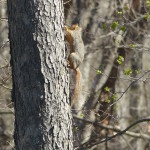
What happens when a squirrel falls?
Squirrels are amazingly agile, but they do slip and fall. It’s not common, but it happens. Rich has seen two squirrels fall from the top of large oak trees.
One squirrel lost its footing on a huge oak tree at the Indian Creek Nature Center when Rich was walking nearby. It spread out its legs and tail and fell horizontally, hitting the ground with a “thump”. Although it fell at least 40 feet the squirrel appeared uninjured, scampered off, and climbed right back up the oak.
Another squirrel fell from an even bigger oak in our home’s backyard. It did the same as the Nature Center Squirrel and spread out its body, hit the ground, and ran right off.
Squirrels rarely fall, but once in a while, they do. Fortunately, as this YouTube video shows, they seem amazingly able to recover from a fall that would instantly kill a human.
What are some of the animals you know as individuals? Let us know!
by Winding Pathways | May 3, 2018 | Birds, Mammals, Nature
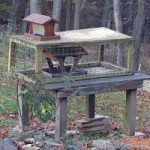
Keeping Squirrels at bay
Bruce Frana, a Winding Pathways visitor, saw one of our blogs on our “squirrel proof” feeder and how we discourage squirrels from gobbling up sunflower seeds we put out for birds. He crafted a similar but much more attractive version that’s in his yard. Our contraption is a box framed with 2X2 lumber with sides of 2” x 2” wire mesh. A piece of plywood forms the roof, and we attached it to a wooden table with a pair of hinges. The hinges let us lift the cage to sprinkle sunflower seeds inside.
It works. Sort of. Cardinals, chickadees, and nuthatches easily pass through the wire mesh to feed. Some squirrels and wild turkeys, which we like but get frustrated when they gobble up all the seed, can’t get through the mesh. Our fox squirrels are too chunky to squeeze through, but smaller gray squirrels manage to get in and gobble seeds. We could keep the grays out if we could find 1 ¾ x 1 ¾ mesh wire on the market. As far as we know it doesn’t exist, but if it did it would let birds in but exclude even the skinniest gray squirrel.
Bruce reports that his fox squirrels can’t enter either but the grays do. Here is a photo of his squirrel foiling feeder:
Do It Yourself “Squirrel Proof” Feeder!
Here is what he shared: “I have had a platform feeder for several years but, like your blog mentioned, turkeys, and even some clever squirrels, were able to get on top of it. I built (a feeder) based on the plan/picture you shared on your blog. I adapted the plan to the platform feeder I had and made some of my own modifications.
“As you can see from the pictures, I attached the structure onto the original platform by using hinges, just as your plan had done. I also put a pitched roof and handle to be able to easily lift the one end to place seed on the platform. The entire system is attached to a 2″ PVC pipe that slides over a steel post. I have had one ingenious small grey squirrel figure out how to get into the feeder and solved that problem, at least for now, by making the wire openings a bit smaller on two sides.” It works…sort of!”
Readers can go online and find “Do It Yourself” (DYI) “squirrel proof” feeder instructions. Good luck and let us know how it goes! Thanks, Bruce Frana.
-
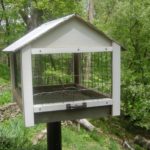
-
Adaptation to feeder
-
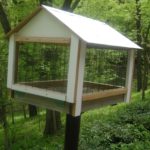
-
Back View of feeder
















